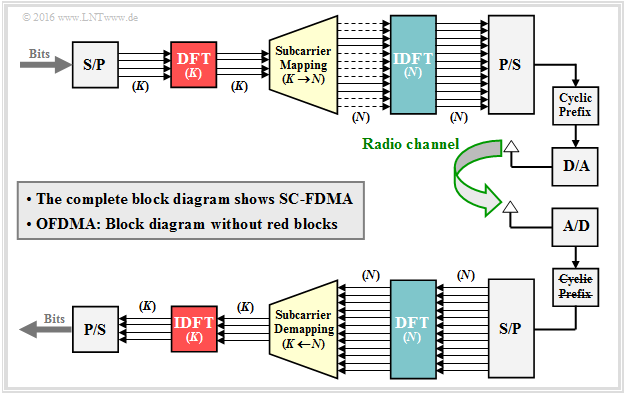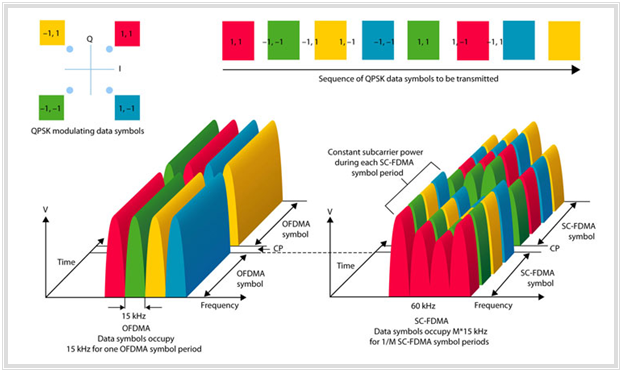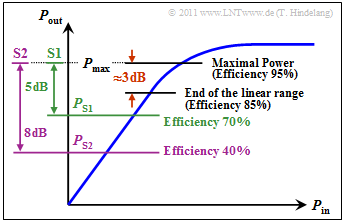Difference between revisions of "Mobile Communications/The Application of OFDMA and SC-FDMA in LTE"
| Line 75: | Line 75: | ||
Let us summarize these statements briefly: | Let us summarize these statements briefly: | ||
| − | {{BlaueBox|TEXT= | + | {{BlaueBox|TEXT= |
$\text{SC–FDMA is different from OFDMA}$ in the following points [see also Internet article [https://en.wikipedia.org/wiki/Single-carrier_FDMA Single-carrier FDMA] (in Wikipedia) and | $\text{SC–FDMA is different from OFDMA}$ in the following points [see also Internet article [https://en.wikipedia.org/wiki/Single-carrier_FDMA Single-carrier FDMA] (in Wikipedia) and | ||
[http://www.rfwireless-world.com/Articles/difference-between-SC-FDMA-and-OFDMA.html Difference between SC-FDMA and OFDMA.html] from (''RF Wireless World'')]: | [http://www.rfwireless-world.com/Articles/difference-between-SC-FDMA-and-OFDMA.html Difference between SC-FDMA and OFDMA.html] from (''RF Wireless World'')]: | ||
Revision as of 20:04, 9 September 2020
Contents
- 1 General information on LTE transmission technology
- 2 Similarities and differences of OFDM and OFDMA
- 3 Differences between OFDMA and SC-FDMA
- 4 Functionality of SC-FDMA
- 5 Verschiedene Ansätze für das Subcarrier–Mapping
- 6 Vorteile von SC–FDMA gegenüber OFDM
- 7 Aufgaben zum Kapitel
- 8 Quellenverzeichnis
General information on LTE transmission technology
In contrast to its predecessor UMTS, Long Term Evolution (LTE) uses a variant of the OFDM concept also used by WLAN to systematically divide the transmission resources. The multiple access method OFDM possesses the ability to protect the system against intermittent transmission disturbances, just like the UMTS–Technology CDMA.
In principle, it would have been possible to adapt and expand the technologies used in the second and third generations of mobile communications in such a way that they also meet the required specifications for the fourth generation. However, the rapidly increasing complexity of CDMA when receiving signals on multiple paths made the technical implementation appear to make little sense.
The highly abstracted graphic shows the distribution of the complete bandwidth for individual subcarriers and explains the difference between CDMA (UMTS) and OFDM (LTE).
- In contrast to CDMA, OFDM has many subcarriers, typically even several hundred, with a bandwidth of only a few kilohertz each.
- To achieve this, the data stream is split and each of the many subcarriers is modulated individually with only a small bandwidth.
LTE uses OFDMA, an OFDM-based transmission technology. Among the reasons for this are [HT09][1]:
- High performance in frequency controlled channels,
- the low complexity in the receiver,
- good spectral properties and bandwidth flexibility, and
- compatibility with the latest receiver– and multi-antenna technologies.
On the next page the differences between the multiple access methods OFDM and OFDMA are briefly explained.
Similarities and differences of OFDM and OFDMA
The principle of Orthogonal Frequency Division Multiplexing (OFDM) is explained in detail in chapter checkLink:_Buch_9 ⇒ Motivation for xDSL of the book "Modulation methods". The diagram above shows the frequency assignment for OFDM: OFDM splits the available frequency band into a large number of narrow-band subcarriers, it is important to note:
- To ensure that the individual subcarriers exhibit as little intercarrier–interference as possible, their frequencies are selected so that they are orthogonal to each other.
.
- This means: At the center frequency of each subcarrier, all other carriers have no spectral components. The goal is to select the currently most favorable resources for each user in order to obtain an overall optimal result.
.
- In concrete terms, this also means that the available resources are allocated to the user who can currently do the most with them, adapted to the respective network situation.
- For this purpose, the base station for the downlink to the terminal device measures the connection quality with the help of reference symbols.
The lower diagram shows the allocation at Orthogonal Frequency Division Multiple Access (OFDMA). You can see:
- For OFDMA the resource allocation after channel fluctuations is not limited to the time domain as with OFDM, but also the frequency domain is optimally included.
- Thus the OFDMA–resource allocation is better adapted to the external circumstances than with OFDM.
- In order to make optimum use of this flexibility, however, coordination between the base station (eNodeB) and the terminal equipment is necessary. More on this in chapter checkLink:_Buch_9 ⇒ General Description of DSL.
Differences between OFDMA and SC-FDMA
There are transmission methods such as
WiMAX, which use OFDMA in both directions. The LTE specification by the 3GPP consortium on the other hand specifies
- In Downlink (transmission from the base station to the terminal) OFDMA is used.
- In Uplink (transmission from terminal to base station) SC–FDMA' (Single Carrier Frequency Division Multiple Access ) is used.
From the graphic you can see that the two systems "SC–FDMA" and "OFDMA" are very similar. Or in other words: SC–FDMA is based on OFDMA (or vice versa).
- If you omit the components highlighted in red ${\rm DFT} \ (K)$ and ${\rm IDFT} \ (K)$ from SC–FDMA, you get the OFDMA–System.
- The other blocks stand for Serial/Parallel–Converter (S/P), Parallel/Serial–Converter (P/S), D/A–Converter, A/D–Converter as well as Add/Remove Prefix.
The signal generation for SC–FDMA works similar to OFDMA, but with small changes that are important for mobile radio:
- The main difference is the additional discrete Fourier-Transformation (DFT).
- This has to be done on the transmit side directly after the serial/parallel–conversion.
- Thus, it is no longer a multi-carrier procedure, but a single-carrier–FDMA–variant.
- One speaks of "DFT–spread OFDM" because of the necessary DFT/IDFT–operations.
Let us summarize these statements briefly:
{{BlaueBox|TEXT= $\text{SC–FDMA is different from OFDMA}$ in the following points [see also Internet article Single-carrier FDMA (in Wikipedia) and Difference between SC-FDMA and OFDMA.html from (RF Wireless World)]:
- With SC–FDMA, the data symbols are sent in a group of simultaneously transmitted subcarriers instead of sending each symbol from a single orthogonal subcarrier as with OFDMA.
- This subcarrier group can then be considered a separate frequency band that transmits the data sequentially. This is where the name "Single Carrier FDMA" comes from.
- While with OFDMA the data symbols directly create the different subcarriers, with SC–FDMA they first pass a discrete Fourier transformation (DFT). Thus the data symbols are first transformed from the time domain into the frequency domain before they pass through the OFDM–procedure.
One can also describe the difference between OFDMA and SC–FDMA in such a way:
- In an OFDMA–transmission, each orthogonal subcarrier only contains the information of a single signal.
- In contrast, with SC–FDMA, each individual subcarrier contains information about all signals transmitted in this period.
This difference and the quasi–sequential transmission with SC–FDMA can be seen particularly well from the following diagram. This is taken from a PDF document from Agilent–3GPP.
Functionality of SC-FDMA
Now the SC–FDMA–transfer process shall be examined more in detail. The information for this comes largely from [MG08][2].
The purpose and function of the Cyclic Prefix is not discussed in detail here. The reasons are the same as for OFDM and can be read in the section checkLink:_Buch_5 ⇒ Cyclic Prefix of the book "Modulation_Methods".
The following description refers to the SC–FDMA–Sender shown here. Note that with LTE the modulation is adapted to the channel quality:
- In highly noisy channels 4–QAM (Quadrature Amplitude Modulation with only four signal space points) is used.
- Under better conditions, the system then switches to a higher-level QAM, up to 64–QAM.
The following also applies:
- An input data block consists of $K$ complex modulation symbols $x_\nu$ which are generated at a rate of $R_{\rm Q}\ \big[\rm symbols/s \big]$ . The discrete Fourier transform (DFT) generates $K$ symbols $X_\mu$ in the frequency domain, which are modulated on $K$ from a total of $N$ orthogonal subcarriers:
- \[X_\mu = \sum_{\nu = 0 }^{K-1} x_\nu \cdot {\rm e}^{-{\rm j} \hspace{0.05cm}\cdot \hspace{0.05cm} { 2 \pi \hspace{0.05cm}\cdot \hspace{0.05cm} \nu \hspace{0.05cm}\cdot \hspace{0.05cm} \mu }/{K}} \hspace{0.05cm},\]
- The subcarriers are distributed over a larger bandwidth of $B_{\rm K} = N \cdot f_0$ where $f_0 = 15 \ \rm kHz$ is the smallest addressable bandwidth for LTE. Unused channels are shown as dashed lines in the example graphic.
.
- The channel transmission rate is $R_{\rm C} = J \cdot R_{\rm Q}$ with spreading factor $J = N/K$. This SC–FDMA–system could simultaneously process $J$ orthogonal input signals. In the case of LTE, for example, the values are $K = 12$ (smallest addressable block) and $N = 1024$. $J$ thus also indicates the number of terminal devices that can be simultaneously connected to this base station.
- According to the so-called subcarrier–mapping , which is the assignment of the symbols generated by the DFT to the available subcarriers, the symbols are then "mapped" to a certain bandwidth, for example $K = 12$ maps to the range of $0 \ \text{...} \ 180 \ \rm kHz$ or to the range of $180 \ \rm kHz \ \text{...} \ 360 \ \rm kHz$.
- The IDFT–transformation (highlighted in blue above) transforms the output values $Y_\mu$ on the frequency domain in its time representation $y_\nu$. These samples are then transformed by the parallel/serial–converter into a sequence suitable for transmission.
Verschiedene Ansätze für das Subcarrier–Mapping
Die folgende Abbildung verdeutlicht drei Arten für das Subcarrier–Mapping. Zur Vereinfachung der Darstellung beschränken wir uns hier auf die (sehr kleinen) Parameterwerte $K = 4$ und $N = 12$.
DFDMA oder Distributed Mapping:
Hier werden die Modulationssymbole auf einen gewissen Bereich der verfügbaren Kanalbandbreite verteilt.
IFDMA oder Interleaved FDMA:
Sonderform der DFDMA, wenn man die Modulationssymbole auf die komplette Bandbreite mit gleichen Abständen verteilt.
LFDMA oder Localized Mapping:
Die $K$ Modulationssymbole werden direkt benachbarten Unterträgern zugeordnet. Dies entspricht der derzeitigen 3GPP–Spezifikation.
Man kann zeigen, dass der Sender bei SC–FDMA die drei Schritte
- Diskrete Fouriertransformation (DFT),
- Subcarrier–Mapping, und
- Inverse diskrete Fouriertransformation (IDFT) bzw. Fast–Fouriertransformation (IFFT)
gar nicht einzeln durchlaufen muss. Diese drei Operationen kann man vielmehr gemeinsam als eine einzige lineare Operation realisieren. Die vollständige und mathematisch nicht einfache Herleitung findet sich zum Beispiel in [MG08][2]. Jedes Element $y_\nu$ der Ausgangssequenz ist dann durch eine gewichtete Summe der Eingangssequenzelemente $x_\nu$ darstellbar, wobei die Gewichte komplexwertig sind.
Anstatt der vergleichsweise komplizierten Fouriertransformation reduziert sich die Operation somit
- auf eine Multiplikation mit einer komplexen Zahl, und
- dem $J$–fachen Wiederholen der Eingangssequenz $\langle x_\nu \rangle $.
In Aufgabe 4.3 wird das (sendeseitige) Subcarrier–Mapping mit realistischeren Werten für $K$ und $N$ betrachtet und auf die Unterschiede zum Subcarrier–Demapping (am Empfänger) hingewiesen.
Vorteile von SC–FDMA gegenüber OFDM
Der entscheidende Vorteil von SC–FDMA gegenüber OFDMA ist auf Grund seiner Einzelträgerstruktur sein niedrigeres Peak–to–Average Power–Ratio $\rm (PAPR)$. Darunter versteht man das Verhältnis von momentaner Spitzenleistung $P_{\rm max}$ zur mittleren Sendeleistung $P_{\rm S}$. $\rm PAPR$ lässt sich auch durch den Crest–Faktor (Quotient der Signalamplituden) ausdrücken. Die beiden Größen sind allerdings nicht identisch.
Die Grafik aus dem Internet–Dokument [Wu09][3] zeigt in doppelt–logarithmischer Darstellung die Wahrscheinlichkeit dafür, dass bei 64–QAM–OFDM die momentane Leistung $P_{\rm max}$ über der mittleren Leistung $P_{\rm max}$ liegt. Man erkennt:
- Die Wahrscheinlichkeit für große „Ausreißer” ist gering. Beispielsweise wird die mittlere Leistung nur in $0.1\%$ der Zeit um mehr als $\text{10 dB}$ überschritten ⇒ rote Markierung.
- Auch wenn solche hohen Leistungsspitzen nur sehr selten sind, stellen sie trotzdem ein Problem für den Leistungsverstärker des Empfängers dar.
Die Leistungsverstärker sollten im linearen Bereich betrieben werden, da ansonsten das Signal verzerrt wird. Nichtlinearitäten ergeben sich insbesondere auf Grund von
- Intercarrier–Interferenz innerhalb des Signals,
- Interferenzen von benachbarten Kanälen aufgrund von Spektrumserweiterungen.
Daher muss bei OFDM der Verstärker die meiste Zeit mit einer niedrigeren Leistung als möglich betrieben werden, was seine Effizienz drastisch reduzieren kann.
- Weil man SC–FDMA quasi als Einzelträger–Übertragungsverfahren betrachten kann, ist bei diesem $\rm PAPR$ niedriger als bei OFDMA.
- Dadurch kann zum Beispiel ein so genanntes Pulse–shaping–Filter verwendet werden, der das $\rm PAPR$ reduziert.
Das niedrigere $\rm PAPR$ ist der wesentliche Grund dafür, dass im LTE–Uplink SC–FDMA zum Einsatz kommt und nicht OFDMA.
- Ein niedriges $\rm PAPR$ bedeutet eine längere Batterielaufzeit, ein für Mobiltelefone/Smartphones äußerst wichtiges Kriterium.
- Gleichzeitig bietet SC–FDMA eine ähnliche Leistungsfähigkeit und Komplexität wie OFDMA.
- Da für den Downlink eine lange Batterielaufzeit weniger bedeutend ist, wird hier OFDMA eingesetzt.
$\text{Beispiel 1:}$ Wir betrachten ein OFDM–System mit $N$ Trägern, alle mit gleicher Signalamplitude $A$. Dann ist nach einer stark vereinfachten Rechnung mit gleichem Proportionalitätsfaktor
- die maximale Signalleistung proportional zu $(N \cdot A)^2$, und
- die mittlere Signalleistung proportional zu $N \cdot A^2$ .
Daraus ergibt sich das Peak–to–Average Power–Ratio als der Quotient dieser beiden Leistungen zu ${\rm PAPR} = N$. Bereits bei nur zwei Trägern ergibt sich schon ${\rm PAPR} = 2$ entsprechend $\text{3 dB}$.
- Somit muss der Verstärker selbst bei nur zwei Trägern immer $\text{3 dB}$ unterhalb der maximalen Leistung arbeiten, um im Fall von Signalspitzen keine Signalverzerrungen zu produzieren.
- Wie anschließend gezeigt wird, bedeuten $\text{3 dB}$ aber bereits einen Rückgang des Wirkungsgrads auf $85\%$.
Das Peak–to–Average Power–Ratio $\rm (PAPR)$ steht in direkter Beziehung zur Sendeverstärkereffizienz. Die maximale Effizienz wird erreicht, wenn der Verstärker in der Umgebung der Sättigungsgrenze arbeiten kann.
$\text{Beispiel 2:}$ Die Grafik zeigt eine beispielhafte Verstärkerkennlinie, also die Ausgangsleistung aufgetragen über der Eingangsleistung.
- Bei $\rm PAPR = 1$ $($also $\text{0 dB})$ könnte man die mittlere Leistung $P_{\rm S}$ gleich der zulässigen Spitzenleistung $P_{\rm max}$ setzen. Gemäß der Kennlinie $P_{\rm out}/P_{\rm in}$ ergäbe sich (beispielhaft) der Verstärkerwirkungsgrad zu $95\%$.
- Bei großem $\rm PAPR$ muss aber der Verstärker unterhalb der Sättigungsgrenze betrieben werden, um zu starke Signalverzerrungen zu verhindern.
Hier einige numerische Beispiele:
- Bei $\rm PAPR = 2$ entsprechend der Überschlagsrechnung auf der letzten Seite müsste man die mittlere Sendeleistung um $\text{3 dB}$ kleiner als zulässig wählen, damit $P_{\rm max}$ zu keinem Zeitpunkt überschritten würde. Der Wirkungsgrad würde so auf $85\%$ zurückgehen.
- Ein Back–off von $\text{3 dB}$ reicht aber meist nicht aus, vielmehr geht man in der Praxis von Werten zwischen $\text{5 dB}$ und $\text{8 dB}$ aus [Hin08][4]. Nach obiger Kurve sinkt aber bereits bei $\text{5 dB}$ der Wirkungsgrad auf nur mehr $70\%$ (System $\rm S1$, grüne Linie).
- Mit dem System $\rm S2$ können zwar alle Signalspitzen kleiner $\text{8 dB}$ vom Verstärker verzerrungsfrei übertragen werden, aber der Verstärkerwirkungsgrad beträgt dann nur noch $40\%$. Wie aus der ersten Grafik auf dieser Seite zu ersehen ist, treten trotzdem noch in ca. $2\%$ der Zeit starke Verzerrungen auf.
- Ist die mittlere Sendeleistung sei $P_{\rm S} = 100\, \rm mW$, so muss bei einem $\rm PAPR = 9 \ \text{(8 dB)}$ der Verstärker bis zu $P_{\rm max} = 900\, \rm mW$ verzerrungsfrei arbeiten, bei $\rm PAPR = 2 \ \text{(8 dB)}$ dagegen nur bis $200 \, \rm mW$. Der Unterschied zwischen den beiden Verstärkern ist ein enormer Kostenfaktor.
$\text{Fazit:}$ Aufgrund dieser Angaben kann zusammengefasst werden:
- OFDM mit einem großen Back–off im Uplink würde zu Problemen führen, nämlich zu extrem kurzen Batterielaufzeiten der mobilen Endgeräte. Daher wird im LTE–Uplink das konkurrierende Verfahren SC–FDMA verwendet.
- Zudem ist die Sender–Komplexität bei SC–FDMA allgemein niedriger als bei anderen Verfahren, was billigere Endgeräte bedeutet [MLG06][5]. Würde man das bei UMTS genutzte CDMA auf den 4G–Standard erweitern, so würde demgegenüber auf Grund der hohen Frequenzdiversität im Kanal die Empfängerkomplexität stark ansteigen [IXIA09][6].
- Allerdings wird die Frequenzbereichsentzerrung bei SC–FDMA komplizierter als bei OFDMA. Dies ist der Hauptgrund, warum man SC–FDMA nur im Uplink verwendet. So müssen diese komplizierten Entzerrer nur in den Basisstationen eingebaut werden und nicht in den Endgeräten.
Aufgaben zum Kapitel
Aufgabe 4.3: Subcarrier–Mapping
Aufgabe 4.3Z: Zugriffsverfahren bei LTE
Quellenverzeichnis
- ↑ Holma, H.; Toskala, A.: LTE for UMTS - OFDMA and SC-FDMA Based Radio Access. Wiley & Sons, 2009.
- ↑ 2.0 2.1 Myung, H.; Goodman, D.: Single Carrier FDMA - A New Air Interface for Long Term Evolution. West Sussex: John Wiley & Sons, 2008. Cite error: Invalid
<ref>tag; name "MG08" defined multiple times with different content - ↑ Wu, B.: Analyzing WiMAX Modulation Quality. PDF–Internetdokument, 2009.
- ↑ Hindelang, T.: Mobile Communications. Vorlesungsmanuskript. Lehrstuhl für Nachrichtentechnik, TU München, 2008.
- ↑ Myung, H.; Lim, J.; Goodman, D.: Single Carrier FDMA for Uplink Wireless Transmission. IEEE Vehicular Technology Magazine, Vol. 1, No. 3, 2006.
- ↑ SC-FDMA – Single Carrier FDMA in LTE. (PDF–Dokument im Internet), 2009.







